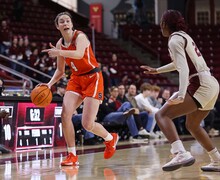Skyhall student housing sees increased number of students move out after fall semester
A total of 26 residents out of 351 have moved out of the Skyhalls residence buildings on South Campus this semester, and many students cite the unequal facilities and distance from main campus as the key factors for their move.
While the Office of Housing, Meal Plan & ID Card Services has housed transfer students in Skyhalls for up to six years, this year the number of students that have moved out is well above average.
“It is a norm to have Skyhall residents leave mid-year after staying there for their first semester,” said Eileen Simmons, the Director of Housing, Meal Plan & ID Card Services. “However, this spring, we definitely experienced a higher volume of students moving out with 13 rooms left vacant in the Skyhalls.”
The three Skyhalls — Skyhall I, II and III— are a 10-minute bus ride from main campus. Skyhalls I and II are reserved for transfer students, while Skyhall I also is home to the College of Arts and Sciences Transfer Learning Community. Skyhall III is part of the housing lottery, allowing other non-transfer students to opt to live there too.
Simmons said that it is important to ensure that students are happy and comfortable with their living experiences. However, some students think the Skyhall buildings could be improved.
Prior to August 2006, Skyhalls were a top residence choice among students because they offered open-double rooms, had a proper kitchen and did not require students to have a meal plan, making it one of the cheapest on-campus locations to live, Simmons said. But the kitchen facilities have since been removed due to bathroom renovations and the addition of new laundry rooms.
Several factors play into why students request to move to main campus, Simmons said, including the need to take a bus and the level of activity on North Campus.
“It’s not programming, I don’t think it’s less serviced and I think the buildings are in great shape,” Simmons said of South Campus. “We even changed Skyhall III to include large singles with full beds and still, Skyhalls don’t seem too popular.”
With some students not as fond of living in Skyhalls, the buildings’ senior staff and resident advisers have made it a priority to better understand and improve residents’ experience.
There have been five focus group sessions scheduled within the next month and a half to collect feedback from Skyhalls’ transfer students, said Leif Olsen, residence director of Skyhalls and Slocum Heights. Olsen said that data collected during the sessions will be used “to inform future transfer student orientation sessions, Skyhalls programming and initiatives and other transfer support systems.”
There have been other improvements already put in place to improve the living experience in Skyhalls.
In the fall, a bus route that travels directly to the Skyhalls from College Place was introduced. This year, the South Campus Wellness Initiative was also introduced, which offers a weekly yoga class in Goldstein Student Center, meaning students do not have to travel to North Campus for a fitness class. The initiative also sponsors cooking demonstrations to help students learn how to prepare quick, easy, healthy meals in their apartments or residence hall rooms.
Jasmine Mangum, vice president of South Campus Organization for Programming Excellence and former Skyhall resident, said these initiatives are beneficial to students, but suggested allowing transfer students to stay elsewhere on-campus, if requested.
“I love Skyhalls but South Campus is for students who have already lived on main, had that first-year experience and now they get the option to move,” Mangum said. “Transfers should be immersing themselves in campus life and part of that is being housed on main campus.”
Published on February 23, 2015 at 12:01 am





